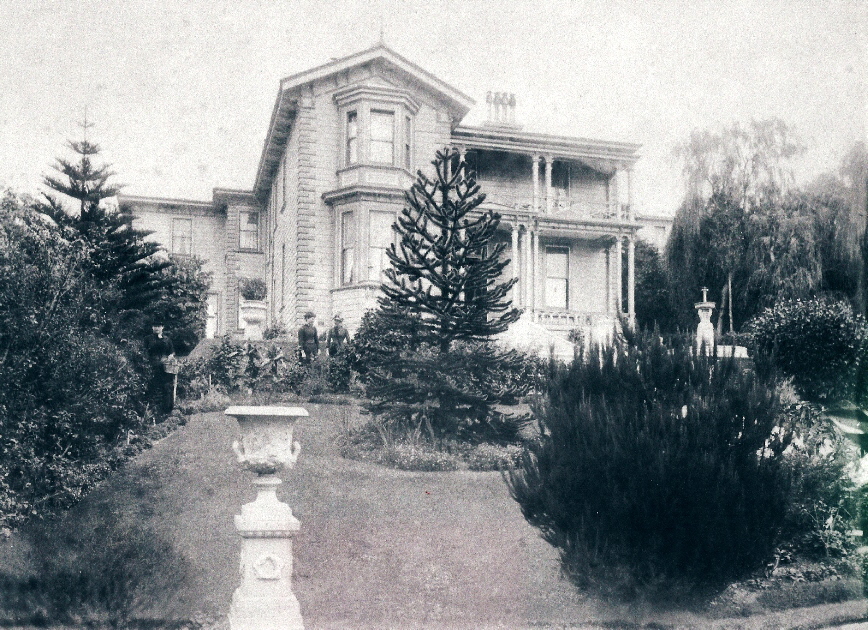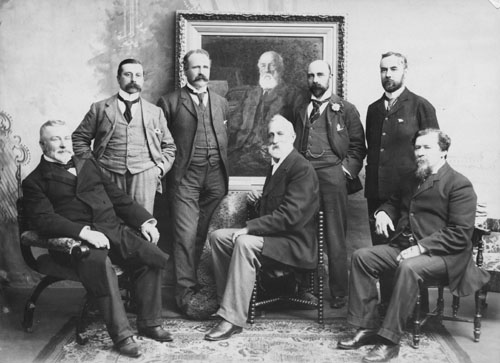The History of Inverlochy House
The Building
Inverlochy House is a Victorian mansion designed by local architect Thomas Turnbull for a prominent local family in the late 1870s. A contemporary account described the ‘unrivalled family residence’ as having ‘fourteen rooms, two bathrooms, every modern convenience, water laid on, two conservatories, a vinery, fernery, fowl house, wash house, offices and a stable with two stalls and loose box’. The house was built for the Macdonald family between 1877 and 1878 using mainly local timbers, but many of the original fittings such as the mosaic tiles in the hall, the ornate carved fireplaces and the two lion fountains at the front of the building were imported from Great Britain and Europe. The house is named after a thirteenth century Scottish castle. In 1431 clansmen of Alexander Macdonald defeated King James the First’s army in the first Battle of Inverlochy, which was fought in the vicinity of the castle.

The front of the house circa 1890 - 1900 (from the collection of the Museum of New Zealand - Te Papa Tongarewa)
The Owners
The house was first owned by Thomas and Frances Macdonald. Thomas was born in Boulogne-sur-mer in France in 1847 but some years later he returned with his parents to the family’s highland home in Scotland. The young man was educated in Dundee and later at Hare’s Private Academy in Adelaide, Australia. It was there in 1870 he married a young Australian woman called Frances Rossiter. The couple arrived in Wellington, New Zealand, in July 1871 and Thomas worked for a time as an accountant with the firm of Jacob Joseph and Company. That year he established his own business; T. Kennedy MacDonald and Company. This grew to include land, estate, share-broking, auctioneering and commission agencies, and operated throughout the Wellington province and beyond. Thomas and Frances produced three sons in the 1870’s but sadly all of them died during the scarlet fever epidemic of 1876. The couple later adopted Vera, one of Frances’s nieces, as their daughter. Thomas became an advocate for local industry and was involved in founding and promoting many local concerns including the early tram and rail networks, the Gear Meat Company and the New Zealand Academy of Fine Arts (NZAFA). His expertise in land matters led to his appointment in the 1880s as auctioneer, auditor and umpire to the Wellington and Manawatu Railway Company, and following the Government Advances to Settlers Act 1894 he became the official valuer of state lands from 1895 to 1901.

This group portrait from around 1899 is of an early meeting of the Council of the New Zealand Academy of Fine Arts Council .
Thomas Macdonald is seated at left. (Photo courtesy of the Alexander Turnball library).
Saving the House
At the turn of the twentieth century the house was divided into a number of self-contained flats and it remained in this condition for seventy years. In 1979 William Development Holdings announced plans to knock it down and build a seven story hotel on the site. The building’s inhabitants were issued with eviction notices but together with other local residents they began a fight to save the historic building. Led by house residents Martin Hanley and Fiona Cameron, the group organised a programme of fundraising activities and public meetings and Inverlochy House became the focus of a wider campaign to preserve the city’s remaining heritage buildings from the wrecking balls of developers.
In November of 1980 the group won their battle (but failed to keep their flats) when William Development Holdings magnanimously arranged to present the building as a gift to the city, for use in the arts. A trust was set up to manage the building which included then mayor Sir Michael Fowler, Warren Goston (for WDH) and Guy Ngan (President of the Academy of Fine Arts). In 2006 the building gained official protection when the New Zealand Historic Places Trust registered it as a Class Two Historic Place. In 1982 the proposed hotel (the Terrace Regency) was built up above Inverlochy House on the Terrace. Inverlochy remained empty from 1981 to March of 1986 when the NZAFA began to restore the house using their own funds and money obtained from grants.
Pilot courses began in 1986, with an initial programme in 1987, but the Art School was not formally launched until December of 1987. At this time there was a ceremony at the house at which the Mayor, Jim Belich, formally announced the beginning of NZAFA’s first comprehensive art education programme, to begin in 1988. The school continued to slowly expand its classes until 1994 when NZAFA voted to close the ‘unprofitable’ operation which had become ‘a drain on Academy finances’. The president of the Academy, Tony Arthur, disagreed with this view and resigned to help set up a new incorporated society comprised mainly of tutors. Since then Inverlochy Art School has run successfully to this day.
.jpg)
The front room on the left. (Photo courtesy of the Museum of New Zealand -Te Papa Tongarewa)
The Ghost
Inverlochy House has had a reputation for being haunted since the 1970s and has recently it has been the subject of an ongoing paranormal investigation by local paranormal investigation group Strange Occurrences. In most reported cases no actual ghost is seen but rather, objects appear to move by themselves. Accounts of this work are included in ‘Spooked – Exploring the Paranormal in New Zealand (Jo Davy & James Gilberd, Random House NZ, 2011). However, at least one person has reported seeing the apparition of a young woman - possibly wearing Victorian clothing - on the first floor landing outside the Print Studio. There are rumors that ‘the ghost’ might be someone who died in a fire in this room around the turn of the last century but there is no solid evidence to support this idea. Other people think it is the ghost of Frances McDonald, who has also been reported as haunting 192 The Terrace.
One witness is Martin Hanley. At the time he was an architecture student and a tenant in the upstairs flat. One night in the early 1980s he and his partner Anna were wondering if it was safe to go out (and leave the house unguarded from the developers) when a large mirror appeared to leap off the wall of its own volition before hitting the wall opposite and sliding slowly (and ‘unnaturally’) down to the floor.
To watch the short documentary on the history of Inverlochy House's ghostly experiences, originally screened in 2001 on TV One in the "Documentary New Zealand Series. New Zealand's Only Haunted Art School", head to: The Haunting of Inverlochy House in Wellington - YouTube.